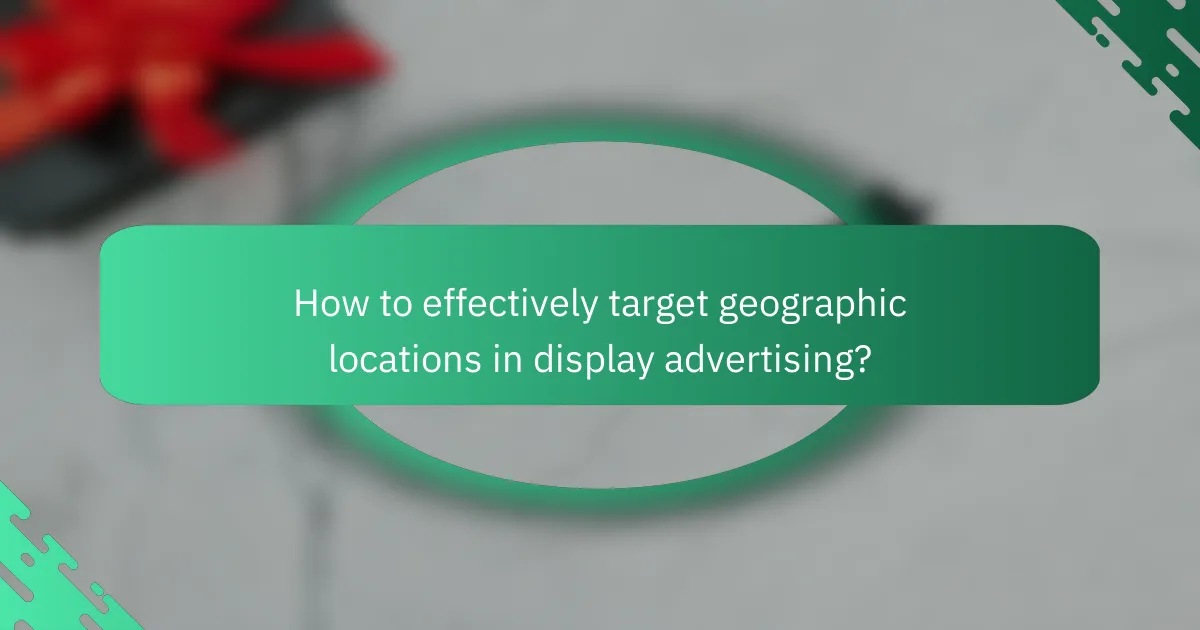Geographic targeting in display advertising is crucial for reaching audiences based on their physical locations, enhancing ad relevance and boosting engagement. In Latvia, key regions such as Riga, Latgale, and Kurzeme present unique opportunities and trends that advertisers can leverage. By analyzing local preferences and behaviors, marketers can tailor their strategies to effectively connect with their target audiences.

How to effectively target geographic locations in display advertising?
Effectively targeting geographic locations in display advertising involves using specific tools and strategies to reach audiences based on their physical location. This approach enhances ad relevance and can significantly improve engagement and conversion rates.
Utilizing geotargeting tools
Geotargeting tools allow advertisers to specify locations for their campaigns, ensuring ads are shown to users in particular regions. Popular platforms like Google Ads and Facebook Ads offer geotargeting features that let you select countries, cities, or even specific zip codes.
When using these tools, consider layering your targeting. For instance, you can target a specific city while excluding surrounding areas to focus your budget effectively. This precision helps in reaching the most relevant audience for your products or services.
Implementing location-based ad campaigns
Location-based ad campaigns leverage geotargeting to deliver tailored messages to users based on their current or past locations. For example, a restaurant can send promotions to users who are nearby, increasing the likelihood of immediate visits.
To implement these campaigns, set clear objectives and choose appropriate ad formats, such as mobile ads that can utilize GPS data. Monitor performance metrics regularly to adjust your strategy based on what resonates with local audiences.
Analyzing local audience behavior
Understanding local audience behavior is crucial for effective geographic targeting. Analyze data from previous campaigns to identify trends in purchasing habits, peak engagement times, and preferred products within specific regions.
Utilize tools like Google Analytics to segment your audience by location and assess how different demographics respond to your ads. This analysis can inform future campaigns, helping you tailor messages that align with local preferences and cultural nuances.

What are the key regions for display advertising in Latvia?
The key regions for display advertising in Latvia include Riga, Latgale, and Kurzeme, each offering unique opportunities and trends. Understanding these areas can help advertisers tailor their strategies to maximize engagement and effectiveness.
Riga as a primary market
Riga is the largest city in Latvia and serves as the primary market for display advertising. With a population exceeding 600,000, it offers a diverse audience and high internet penetration rates, making it an attractive location for advertisers.
In Riga, digital advertising strategies often focus on urban demographics, including young professionals and students. Advertisers should consider using localized content and targeted campaigns to engage this audience effectively.
Regional trends in Latgale
Latgale, located in the eastern part of Latvia, presents different advertising dynamics compared to Riga. This region has a smaller population and a unique cultural identity, which influences consumer behavior and preferences.
Advertisers in Latgale should focus on community-oriented campaigns and local events to resonate with residents. Utilizing regional languages and culturally relevant themes can enhance engagement and brand loyalty.
Emerging opportunities in Kurzeme
Kurzeme, situated in the western part of Latvia, is seeing emerging opportunities for display advertising, particularly in tourism and local businesses. The region’s scenic landscapes attract visitors, creating a potential market for travel-related advertising.
Advertisers should leverage seasonal trends and local attractions in their campaigns. Collaborating with local businesses and tourism boards can amplify reach and effectiveness, making it essential to stay updated on regional events and promotions.

How to analyze local trends for better targeting?
To analyze local trends effectively for better targeting, focus on understanding the preferences and behaviors of your specific audience in a given area. This involves utilizing various tools and methods to gather insights that can inform your marketing strategies.
Using Google Trends for local insights
Google Trends allows you to explore the popularity of search queries in specific regions over time. By entering keywords relevant to your business, you can see how interest varies geographically, which helps identify local trends.
Consider filtering results by location to pinpoint what topics are trending in your area. This can guide your content creation and advertising strategies to align with local interests.
Leveraging social media analytics
Social media platforms provide valuable analytics that reveal how your audience interacts with your content. Tools like Facebook Insights or Instagram Analytics can show demographic data, engagement rates, and popular posts among local users.
Use this information to tailor your messaging and campaigns to resonate with local preferences. Pay attention to the types of content that generate the most engagement in your target area.
Conducting surveys for audience preferences
Surveys are a direct way to gather information about your audience’s preferences and behaviors. Create simple questionnaires that ask about local interests, shopping habits, and preferred communication channels.
Distributing surveys through email or social media can yield valuable insights. Aim for a diverse sample to ensure your findings accurately reflect the local market, and consider offering incentives to increase participation rates.

What criteria should be considered for geographic targeting?
When considering geographic targeting, it is essential to evaluate location-specific factors that influence market behavior. Key criteria include demographic factors, economic conditions, and cultural influences, which can significantly impact the effectiveness of targeting strategies.
Demographic factors
Demographic factors encompass age, gender, income level, and education, which can vary widely across different regions. For instance, targeting a younger population in urban areas may require different messaging compared to older demographics in rural settings. Understanding these differences helps tailor marketing efforts to resonate with specific groups.
Additionally, analyzing population density can inform decisions about resource allocation and advertising channels. High-density areas may benefit from digital marketing, while lower-density regions might require more traditional outreach methods.
Economic conditions
Economic conditions, such as employment rates and average income, play a crucial role in geographic targeting. Regions with higher disposable income may respond better to premium products, while those with lower income levels might require budget-friendly options. Understanding local economic trends can guide pricing strategies and product offerings.
It’s also important to consider the overall economic stability of a region. Areas experiencing economic growth may present opportunities for expansion, whereas regions facing downturns might necessitate a more cautious approach.
Cultural influences
Cultural influences include local customs, values, and social norms that can affect consumer behavior. For example, marketing messages that resonate in one culture may not be effective in another due to differing beliefs and practices. Tailoring content to align with local culture enhances engagement and acceptance.
Moreover, language preferences and regional dialects can impact communication strategies. Utilizing local languages and culturally relevant references can improve relatability and foster a stronger connection with the target audience.

What are the emerging trends in geographic targeting?
Emerging trends in geographic targeting focus on leveraging technology to enhance precision and relevance in advertising. These trends include the use of artificial intelligence, hyper-local strategies, and augmented reality, which collectively aim to improve customer engagement and conversion rates.
Increased use of AI in ad targeting
The integration of artificial intelligence in ad targeting allows businesses to analyze vast amounts of location-based data quickly. AI algorithms can identify patterns in consumer behavior, enabling more tailored advertising strategies that resonate with specific demographics in various regions.
For instance, retailers can use AI to determine the best times to send promotions based on local shopping habits, optimizing their outreach efforts. This data-driven approach can lead to higher engagement rates and improved return on investment.
Growth of hyper-local advertising
Hyper-local advertising focuses on targeting consumers within a very specific geographic area, often down to a neighborhood or even a street. This trend has gained traction as businesses recognize the value of reaching potential customers who are nearby and ready to make a purchase.
Examples include local restaurants using geofencing to send special offers to mobile devices when customers are within a certain radius. This strategy not only increases foot traffic but also fosters a sense of community connection.
Integration of augmented reality in campaigns
Augmented reality (AR) is becoming a powerful tool in geographic targeting, allowing brands to create immersive experiences that engage users in their local environment. AR can enhance product visualization, making it easier for consumers to see how a product fits into their lives.
For example, a furniture store might use AR to let customers visualize how a sofa would look in their living room before making a purchase. This interactive approach can significantly boost customer satisfaction and drive sales, especially in urban areas where competition is fierce.
